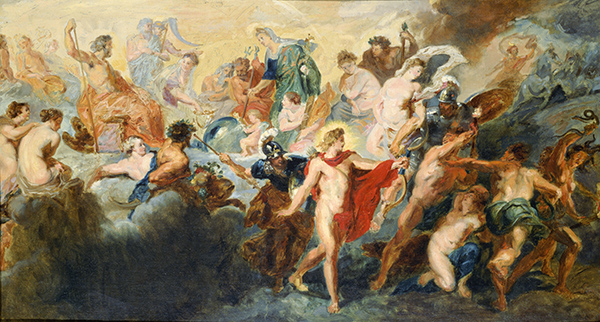
JUNE 8–SEPTEMBER 22, 2019
EARLY INFLUENCES
Pierre-Auguste Renoir (French, 1841-1919), Copy after "The Council of the Gods" by Peter Paul Rubens, 1861. Oil on canvas, 18 1/16 × 32 7/8 in. National Museum of Western Art, Tokyo, Donated by Mr. Ryuzaburo Umehara
By 1845 Renoir’s family had moved from Limoges to Paris in search of work, first settling on the rue de la Bibliothèque and then on the rue d’Argenteuil. Their new home was in such proximity to the Musée du Louvre that Renoir would later recount to dealer Ambroise Vollard that it was practically “included within the wings of the Louvre.”
The greatest impetus to Renoir’s early engagement with fine art was provided by the museum, which since 1793 had been free and open to the public. In these hallowed galleries, Renoir encountered innumerable examples of historical and mythological paintings and sculptures of the nude. He frequented the Greek and Roman sculpture in the ground-floor antiquities galleries, and then became enthralled by the great colorists: François Boucher, Eugène Delacroix, and Peter Paul Rubens, among others. These painters’ lush palettes and command of the human form held lifelong sway over Renoir’s own practice. At the end of his life, he claimed, “I never thought of myself being a revolutionary painter; I just wanted to continue in the tradition of the Louvre.”
Offering the first-ever comprehensive investigation of Renoir’s nudes, Renoir: The Body, The Senses was published by the Clark Art Institute and edited by the exhibition’s curators, Esther Bell, Robert and Martha Berman Lipp Chief Curator of the Clark Art Institute, and George T. M. Shackelford, deputy director of the Kimbell Art Museum. This beautifully illustrated catalogue includes essays by Colin B. Bailey, Morgan Library & Museum; Martha Lucy, Barnes Foundation; Nicole R. Myers, Dallas Museum of Art; and Sylvie Patry, Musée d’Orsay; with an interview between contemporary figurative painter Lisa Yuskavage and Alison de Lima Greene, Museum of Fine Arts, Houston.


